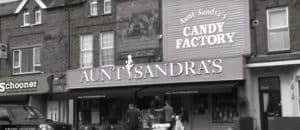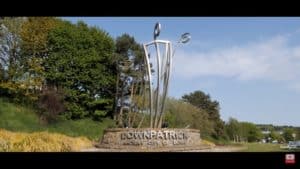The Tango Districts of Buenos Aires: Unveiling the Street’s Fiery Pulse
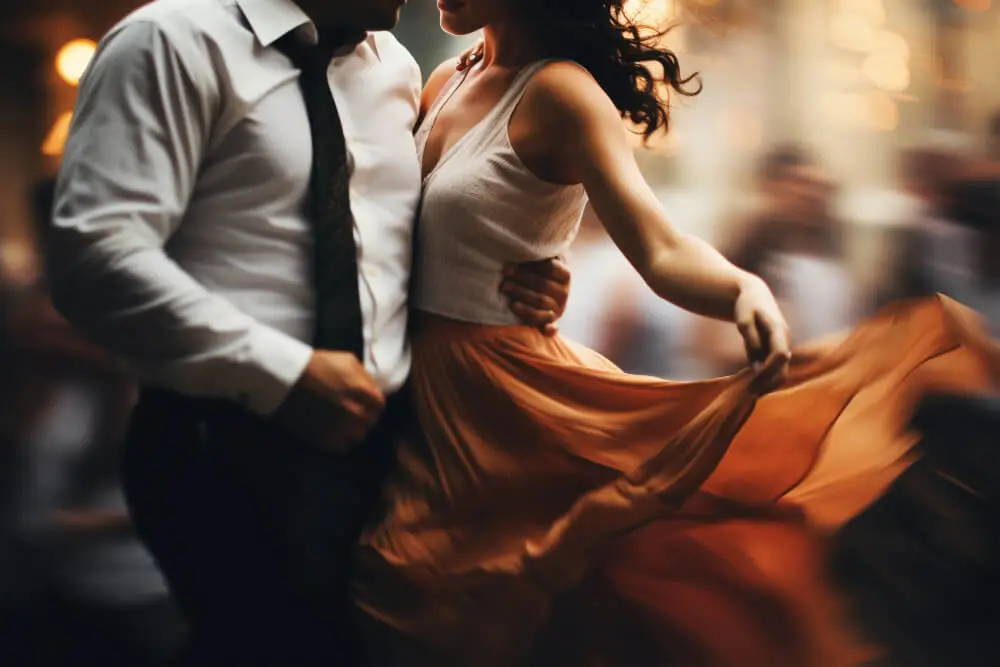
Updated On: April 06, 2024 by Yasmin Elwan
Buenos Aires, a city that pulsates with the rhythm of tango, invites travellers to experience its unique culture deeply rooted in this sensual dance. The streets of Buenos Aires are a testament to the city’s passion for tango, which is more than just a dance; it’s a cultural artefact that embodies the city’s soul. From the vibrant neighbourhoods where it was birthed to the pulsating milongas where it thrives today, tango is interwoven with the city’s history and everyday life.
Exploring the tango districts of Buenos Aires offers visitors a glimpse into the heart of Argentina’s tango culture. The cobblestoned streets echo with the footsteps of dancers while the music envelopes you, telling stories of love and loss. Tango here is a living art form, evident in the social interactions at milongas, the attention to musicality, and the revered dance styles that vary from one district to another. For anybody looking to understand the essence of Buenos Aires, delving into the tango districts is an absolute must.
The Birth of Tango in Buenos Aires
In the vibrant streets of Buenos Aires, the tango emerged as a passionate and emblematic dance, creating an indelible mark on Argentina’s cultural landscape.
Tango’s Origins
Tango originated in the late 19th century, blossoming in the burgeoning neighbourhoods portside along the Río de la Plata. It was here, in the melting pot of Buenos Aires, that a cultural concoction of European immigrants, African rhythms, and native influences coalesced to form the early foundations of tango. This dance reflected the city’s diversity, drawing from the Cuban habanera, the Argentine milonga, and the Uruguayan candombe. Informative insights into this cultural phenomenon illuminate tango’s intangible heritage, as acclaimed by UNESCO.
Influential Figures
Heralded as the ‘King of Tango,’ Carlos Gardel was instrumental in popularizing the dance both within Argentina and internationally in the early 20th century. His charismatic voice and mesmerising performances captured the hearts of audiences, contributing significantly to tango’s golden age. Besides Gardel, other towering figures like Astor Piazzolla, who brought a new flavour to the genre with his innovative compositions, and Osvaldo Pugliese, known for his deep and powerful arrangements, played pivotal roles in the evolution of tango.
Tango Evolution
Tango’s evolution is a testament to Buenos Aires’ dynamic spirit. It began as a dance of the lower classes, often frowned upon by the elite, yet managed to enthral society as a whole, transcending class boundaries. Gradually, it infiltrated posh salons and Parisian stages, growing in complexity and sophistication. As figures like Piazzolla transformed the music with jazzy elements and classical incorporations, the dance likewise matured, branching into diverse styles from the intimate salon tango to the showy stage tango. Tango is a living art that continues to evolve and captivate the world while its soul remains deeply rooted in the streets of Buenos Aires.
The Iconic Tango Districts of Buenos Aires
Buenos Aires, the birthplace of tango, hosts several districts where this passionate dance is not just a tourist attraction but a way of life. These neighbourhoods brim with history, and their streets resonate with the rhythmic melodies of tango music.
San Telmo
San Telmo is one of the oldest barrios in Buenos Aires and is renowned for its antiquated charm and the tango that spills onto its cobblestone streets. On Sundays, the neighbourhood comes alive with the Feria de San Telmo, an antique market that often features spontaneous tango performances. The old-world architecture provides a stunning backdrop for dancers, making it a beloved spot for both locals and visitors alike to enjoy authentic tango.
La Boca
Home to the vibrant Caminito street, La Boca’s colourful houses and artistic murals set a picturesque stage for tango dancers. Historically a neighbourhood of immigrants and artists, it is said that tango flourished here in the early 20th century. As you walk along El Caminito, it’s common to witness intense, passion-filled tango shows that draw crowds and captivate onlookers with their emotional depth and technical precision.
Abasto
Abasto is famously linked with Argentina’s legendary tango singer Carlos Gardel and has a rich tango heritage of its own. The neighbourhood’s focal point is the Abasto Shopping Centre, once a bustling marketplace, which now stands as a modern shopping hub surrounded by tango-inspired art and cultural spaces. Theatres and tango halls around Abasto offer a deep dive into the immersive world of tango, showcasing it as an art form ingrained in the local culture.
Milongas: The Heart of Tango Culture
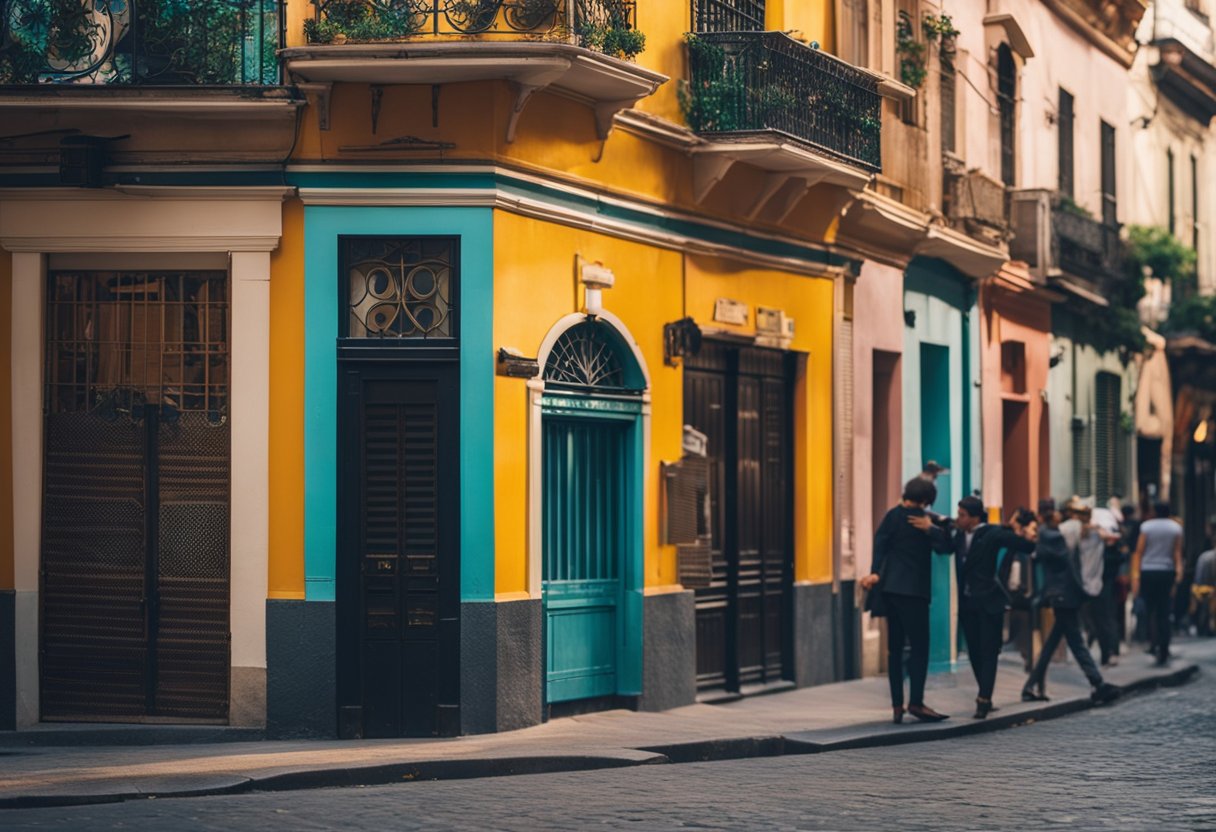
Milongas, the vibrant social dance events central to tango culture, offer an electrifying blend of traditional rhythms and modern beats. Here, visitors join locals in a shared passion for the tango, a dance that has become emblematic of Buenos Aires’ soul.
Traditional Milongas
At the core of tango’s tradition are the Traditional Milongas, places where the essence of this dance prevails. Locals, or ‘porteños’, along with tourists, flock to historic venues like La Ventana—a locale steeped in nostalgia with its classic decor and intimate ambience. Over in San Telmo, Plaza Dorrego comes alive with the spontaneous energy of dancers embracing the night under the open sky. It’s here that one can witness the timeless customs of the milonga, where respectful nods, or ‘cabeceos’, silently invite partners to the dance floor.
Modern Milongas
Contrasting with these time-honoured scenes are the Modern Milongas. Innovative and daring, these venues cater to a new generation of tango enthusiasts seeking to dance tango with a contemporary twist. Displaying a fusion of traditional tango elements with modern music styles and dance forms, these milongas signal the evolving nature of Buenos Aires’ tango scene. They provide a space where both the seasoned ‘milonguero’ and inquisitive tourists can mingle, each bringing a unique perspective to the dance.
The Tango Experience for Visitors
In Buenos Aires, visitors can deeply immerse themselves in tango culture, from mesmerising shows to hands-on dance lessons. Tango is not just a dance—it’s an expression of Argentine passion and history.
Tango Shows
Buenos Aires offers an array of tango shows ranging from intimate, candle-lit venues to grand, theatrical performances. Visitors can expect a night of dramatic flair and raw emotion, culminating in a spectacle of skilful dancers and live orchestral music. These performances often also provide the option of a sumptuous dinner, making for an unforgettable evening. Reserve a spot at one of these shows and experience the true essence of Tango Argentino.
Learning Tango
For those inspired to learn to dance, Buenos Aires is the perfect classroom, offering private and group lessons for dancers of all levels. Beginners can find joy in the basics of tango in studios where some of the greats once trained. Prepare to embark on a journey through time with each step as you learn the traditional movements that make up this iconic dance. Connect with local dancers and feel the passion of tango through private classes.
Tango Tours
Enthusiasts wanting a comprehensive look at the tango culture in Buenos Aires can opt for a tango tour. These tours guide visitors through historic tango districts, milongas (tango dance events), and often include interactive elements like a mini lesson or a show. It’s an opportunity not only to see tango performances but to understand the dance’s deep roots in Argentine history and the daily life of Porteños (residents of Buenos Aires). Engage more intimately with the vibrant tango scene through an immersive tango tour.
Tango Music and Dance Styles
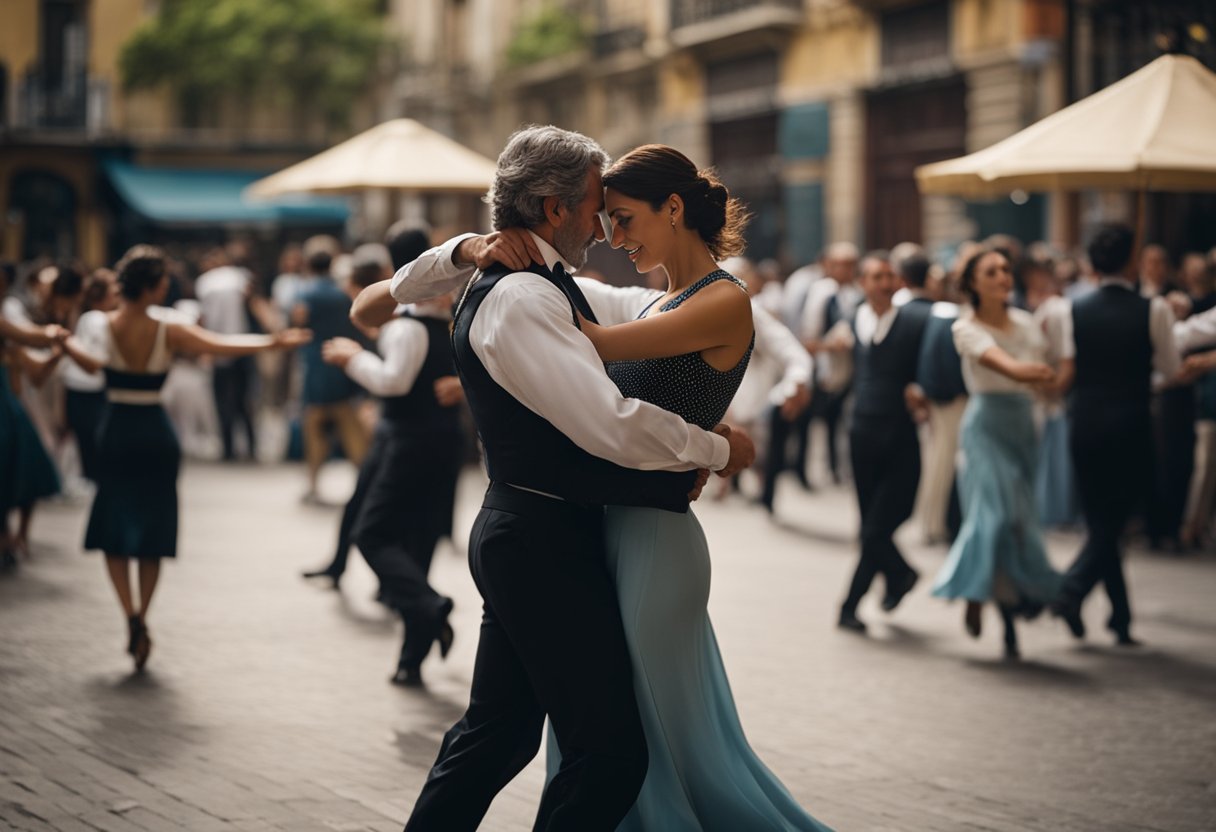
Tango reflects the vibrant spirit of Buenos Aires, encapsulating a range of music and dance styles that contribute to its rich culture. Each style boasts its own unique characteristics that influence the way dancers and musicians express themselves within the Argentine tango tradition.
Orquesta Típica
Orquesta Típica refers to the traditional tango orchestras that have been pivotal in shaping the classic sounds associated with Argentine tango. Typically comprising violins, bandoneons, pianos, and double bass, these orchestras create a rich, layered acoustic experience. The music produced is complex, with rhythmic variations designed to complement the dance intimately.
Tango Nuevo
Tango Nuevo, as the name suggests, is a modern evolution of traditional tango music and dance. It incorporates elements from other dance styles and music genres to create a more contemporary form of tango. This style is known for its innovative approach to melody, harmony, and rhythm, which often pushes the boundaries of traditional tango structures.
Styles and Techniques
Tango encompasses a variety of styles and techniques, each with its own distinct flair. The dance typically involves a close embrace and precise, intricate footwork. Milongas, the social events where tango is often danced, serve as the testing ground for dancers of all levels to refine their skills. The style of dance at milongas can range from the reserved and complex ‘Tango de Salon’ to the more dramatic and showy ‘Tango Escenario’. Each style demands a deep connection with the music and an understanding of the subtle cues given by one’s partner.
Social and Cultural Significance of Tango
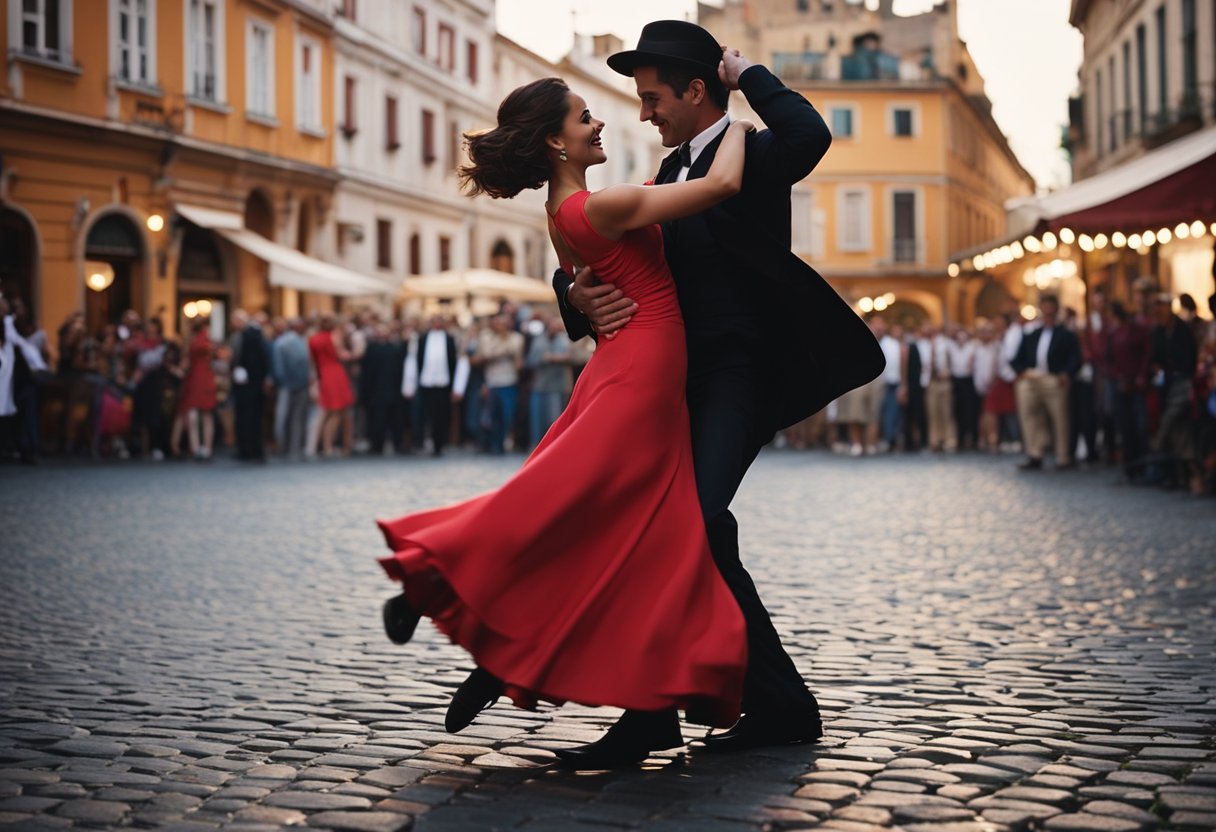
The Tango, a dance intricately woven into the fabric of Buenos Aires, serves as a living testament to the city’s vibrant culture and history. As we explore its significance, we find that Tango is not merely a dance but a cultural treasure that has shaped the Argentine identity and continues to resonate with the Porteños.
Tango as Intangible Heritage
Tango transcends the realm of dance to embody an intangible cultural heritage steeped in history and emotion. It is the physical articulation of the stories and struggles of early 20th-century immigrants, blending African, European, and indigenous influences into a passionate expression. Tango rituals, such as the ‘milonga’, have become a cornerstone of this heritage, offering a communal space where all layers of society merge in a shared, rhythmic experience. Through Salon Style Tango, we witness the celebration of connection and tradition, sustaining the dance’s essence across generations.
Tango’s Role in Argentine Identity
Tango’s influence on the Argentine identity is profound. It’s a symbol of national pride and a pivotal element of cultural identity for Argentines. The art form’s evolution, from the streets of Buenos Aires to the global stage, highlights the dynamic and resilient spirit of the Porteños. Tango serves as a cultural ambassador, showcasing the depth and complexity of Argentine society. Its popularity and passionate culture have made it an emblematic representation of the nation, reinforcing the sense of unity amongst Argentines. As we step into the world of Argentine Tango, we embrace its multifaceted role in painting a vivid portrait of Argentine culture.
Tango Nightlife in Buenos Aires
The tango nightlife in Buenos Aires is a vibrant tapestry of traditional bars, bustling dance halls, and captivating live music venues. Each offers a unique way to experience the passion and drama of Argentina’s most famous dance.
Tango Bars
In the heart of Buenos Aires, tango bars such as El Beso provide an intimate setting where the spirit of tango feels almost tangible. These places are as much about socialising as they are about dancing, offering visitors a glimpse into the local tango culture. Tango aficionados gather in these authentic bars to share stories, practice their moves, and enjoy the enigmatic rhythms of the dance until the early hours of the morning.
Dance Halls and Clubs
Beyond the bars, dance halls and clubs are the pulse of the tango nightlife. Vibrant venues like La Viruta Tango Club welcome dancers of all levels with open arms, featuring large dance floors that invite everyone to join the flow of the milonga. It’s here that the evening transforms into a communal experience, one where strangers become dance partners, and the language of tango transcends all barriers.
Live Music Venues
For those searching for the live soul of tango music, Buenos Aires’ live music venues are a treasure trove. The city’s rich nightlife includes stages where tango is performed live, offering an intense sensory experience that’s felt as much in the heart as it is heard by the ear. From small, atmospheric establishments to grand theatres honouring iconic figures like Astor Piazzolla, these venues are where tango music lives and breathes, pulsating through the night.
The Tango Economy
Within the vibrant streets of Buenos Aires, tango is not merely a dance; it’s an economic life force. From bolstering tourism to providing a livelihood for local artisans, tango is a central thread woven into the cultural and economic fabric of the city.
Tango’s Impact on Tourism
Each year, Buenos Aires welcomes a multitude of tourists, many drawn by the magnetic pull of tango. Tango shows, milongas, and festivals lead visitors through a passionate journey, leaving an indelible mark on the city’s tourism sector. The dance of tango transforms our simple streets into stages, where locals and travellers alike partake in the rhythm. Indeed, this traditional dance form is crucial to the local economy, with many residents earning their livelihood by performing, teaching, or offering tango-related services that appeal to both domestic and international visitors. Hotels, restaurants, and transport services thrive alongside these cultural experiences, forming an intricate network that fuels a significant portion of Buenos Aires’ tourism revenue.
Local Tango Artisans
Beyond the dance floors and theatres, tango’s economic influence extends to the craftsmen and artisans of the city. Buenos Aires prides itself on a strong tradition of craftsmanship, where local artisans diligently create custom tango shoes and garments. These creators are the backbone of a distinctive niche market, and their finely crafted products are sought after by both novice and experienced dancers of the tango community.
Tailors specialising in elegant tango attire contribute to the economy and keep the spirit of the dance tangible, even off the floor. In the city’s traditional neighbourhoods, artisanal leather workers meticulously fashion dance shoes designed to glide effortlessly across the polished surfaces of the milongas. These shoes, along with handcrafted accessories, often feature at local markets, boutique shops, and online stores, underpinning an essential economic sector driven by our love for dance.
Indeed, as much as tango is a dance and an emblem of our cultural identity, it’s also a thriving economy, cementing the role of Buenos Aires as the heartbeat of passion on and off the dance floor.
Festivals and Events
In Buenos Aires, the spirit of tango permeates the air, especially during the city’s renowned tango festivals and championships. These events offer a full immersion into the dance and music that define the cultural essence of Argentina.
Annual Tango Festival
Each August, Buenos Aires becomes the epicentre of tango with its Annual Tango Festival. The festival is a celebration that spans several days, featuring an array of free performances, workshops, and social gatherings dedicated to tango. Patrons and lovers of this passionate dance from across the globe come to experience the vibrancy and soul of Buenos Aires through this art form.
World Tango Championships
The World Tango Championships are a key highlight, occurring concurrently with the Annual Tango Festival. This prestigious competition attracts the finest salon and stage tango dancers who compete for the coveted title. The championships showcase a level of skill and passion that is inspirational, further reinforcing the profound connection between Buenos Aires and tango.
Culinary Delights and Tango
In Buenos Aires, the intermingling of tango and gastronomy offers a feast for the senses, with authentic culinary experiences accentuating the passion of the dance.
Tango Cafés
Café Tortoni, the city’s oldest café, stands as a beacon of Buenos Aires’ café culture. Here, locals and tourists alike can sip on mate or a strong coffee while absorbing the nostalgic atmosphere where poets and artists have historically gathered. The tables at Tango Cafés, often filled with chatter and the aroma of freshly brewed coffee, serve as preludes to the evening’s main tango events.
Dinner and a Show
An evening in Buenos Aires is incomplete without indulging in the flavours of Argentine cuisine, followed by a tango show. Venues across the city offer a ‘dinner and a show’ package where the intense flavours of local dishes such as bife de chorizo (sirloin steak) pair wonderfully with the dramatic flair of the dancers. Authentically prepared dinners offer a culinary journey complementing the sultry experience of live tango.
Tango’s Influence Beyond Argentina
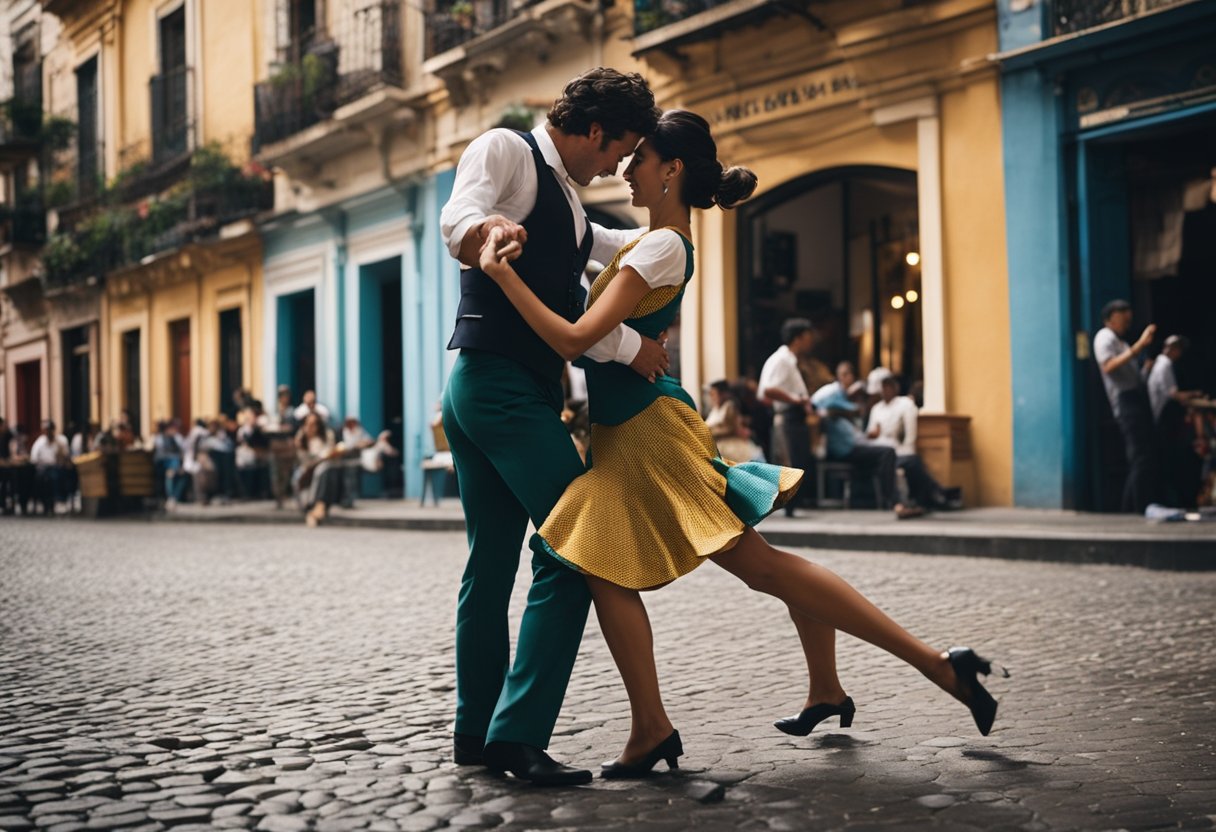
Tango, the sensual dance that originated in Buenos Aires, has captivated hearts and inspired feet across the globe, becoming a phenomenon that transcends its Argentine roots.
Global Popularity
Argentine tango has seen a surge in global popularity, with communities of tango enthusiasts thriving in diverse cities worldwide. Major metropolitan areas boast their own tango schools and milongas, where dancers of all levels gather to dance and socialise. This dance form has become a symbol of passion and expression far beyond the streets of Buenos Aires.
Tango on Stage and Screen
The passionate embrace of Argentine tango has made its way onto both stage and screen. Celebrated productions on Broadway and in theatres around the world have featured the tango, often highlighting its dramatic potential and emotive movements. On film, tango sequences often serve to intensify a scene’s emotion, showcasing the dance’s storytelling prowess.
Cultural Exchange
Tango serves as a profound medium for cultural exchange. Through festivals, workshops, and performances, artists and aficionados share information and techniques, creating a dialogue between cultures. These exchanges enrich the global arts scene and ensure the ongoing evolution and appreciation of tango across continents.
Frequently Asked Questions
We’ve compiled some of the most common questions people have about experiencing the vibrant tango culture in Buenos Aires. These inquiries will guide you through the heart and soul of the city, as expressed in its passionate embrace of tango.
Where can one find tango performances in Buenos Aires?
Tango performances in Buenos Aires can be found in various venues, from grand theatres to intimate neighbourhood milongas. For a truly elaborate show, many places offer impressive theatrical tango shows with live orchestras.
How has tango shaped the cultural identity of Buenos Aires?
Tango has profoundly shaped the cultural identity of Buenos Aires by weaving itself into the fabric of the city’s daily life. It’s a reflection of the city’s history, passion, and artistic expression, and you can feel this cultural pulse on every street corner.
What are the recommended tango shows according to Tripadvisor reviews?
Tripadvisor reviews often highlight the city’s most captivating tango shows. Detailed reviews point towards the elegance and sophistication of shows in various Buenos Aires locales.
Can visitors experience authentic tango in the neighbourhoods of Buenos Aires?
Yes, visitors can experience authentic tango in several neighbourhoods across Buenos Aires. The spirit of tango is ever-present, not just in theatres but also in local milongas and on the streets of Buenos Aires, which serve as spontaneous stages for dancers.
Is there a schedule for open-air tango events at Plaza Dorrego?
Plaza Dorrego, a popular spot in the historic San Telmo district, hosts open-air tango events that attract both locals and tourists. Regular schedules for these events can usually be found by checking local listings or visiting tourist information centres once in the city.


